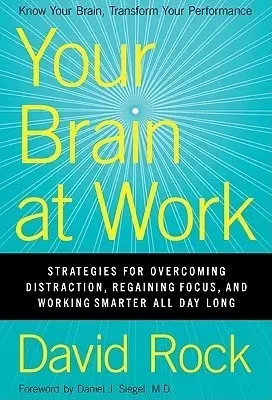
Your Brain at Work
By David Rock
Published October 13, 2025
David Rock translates neuroscience into daily practices for knowledge workers. Your brain has limited “stage space” for focus, burns glucose quickly under load, and is easily hijacked by distractions. The fix isn’t more willpower—it’s better design: protect peak energy for hard thinking, batch decisions, reduce context switches, and use short resets to recover. This summary distills the core strategies to do more of the right work with less friction.
Key Lesson
Protect attention like a small stage—give your biggest work a solo scene.
Focus What Matters
Book Snapshot
ISBN
9780061771293
ASIN
0061771295
Topics & Search Phrases

Full Summary
Your Brain at Work is a field guide to thinking clearly when your job is to think. David Rock blends stories with research to show how everyday choices—when you schedule deep work, how you handle email, what you do between meetings—either tax your brain or set it up to perform.
Rock’s central metaphor is the “stage.” Attention is a small stage where a few actors (ideas) can perform at once. Try to cram too many actors on the stage and the performance collapses: you forget lines, miss cues, and burn energy without moving the plot. The implication is simple: single‑task your most important work. Multitasking isn’t two performances at once; it’s one performance with constant set changes—expensive and error‑prone.
Energy management matters as much as time. The prefrontal cortex—your planning and decision center—fatigues quickly. Schedule heavy cognitive work when energy is naturally high and save low‑stakes tasks for troughs. Use short recovery loops (water, a fast walk, breathing) to reset. Treat snacks and caffeine as tools, not crutches that backfire. Build days around 90‑minute focus arcs and 10–20 minute breaks so your brain can return refreshed.
Context switching is the quiet killer. Each switch (code → chat → email → deck) costs time and error. Rock recommends batching: process email in windows, group similar tasks, and protect at least one contiguous block for deep work. External scaffolding helps—checklists, visual queues, and calendars that show the first action in the event title. Offload working memory so the stage stays clear for thinking, not juggling.
Emotions are energy. Threat states (fear, shame, uncertainty) shrink the stage. Rock’s SCARF model—Status, Certainty, Autonomy, Relatedness, Fairness—explains why certain interactions feel threatening and how to design around them. Increase certainty with clear next steps; give autonomy over process; create relatedness with quick human check‑ins; protect fairness by explaining tradeoffs. When you reduce social threats, you release cognitive capacity for the work itself.
Decision quality improves when you separate phases: explore options, then decide. Mix them and you argue in circles. Name your decision criteria before comparing alternatives, and limit choices to avoid analysis loops. For recurring choices, decide once with rules. For novel ones, pre‑commit to a timebox, then choose and move forward, gathering evidence through action.
The book’s practicality shines in micro‑habits: write the first 60 seconds of a task, single‑tab your browser during deep work, use physical cues to start (open the doc, put on headphones), and capture one line of “what moved” after each focus block. Over a week, these small moves add up to calmer days and more decisive progress.
Ultimately, Your Brain at Work isn’t about becoming superhuman. It’s about removing the friction that keeps a normal brain from doing its best work. Protect the stage for your biggest scene; let the rest happen offstage with systems.
See also: The Effective Executive, The 90‑Minute Focus Block, Thinking, Fast and Slow
Key Takeaways
- Single‑task deep work; the brain’s “stage” can only hold a few actors at once.
- Schedule hard thinking at peak energy; use short recovery loops between arcs.
- Batch email and similar tasks to reduce context switching and errors.
- Use external scaffolding—checklists, calendars, cues—to offload working memory.
- Reduce social threats with SCARF: status, certainty, autonomy, relatedness, fairness.
- Decide by criteria first, then choose; timebox to avoid analysis loops.